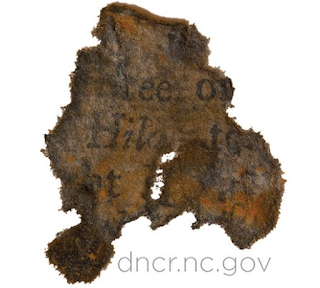Written by the TreasureGuide for the exclusive use of treasurebeachesreport.blogspot.com.
 |
Scrap of Paper Recovered from Queen Annes Revenge
Source: Salisbury Post (See link below)
|
What did Blackbeard's pirates read? You might be surprised if he read at all, but small scraps of paper including the one shown above was recovered from the Queen Anne's Revenge and identified as being from“A Voyage to the South Sea, and Round the World, Perform’d in the Years 1708, 1709, 1710 and 1711” by Captain Edward Cooke. I imagine the book might have been a very useful resource for seamen of the day. And maybe they just liked to read the same type of things we read today.
Here is a bit of the article.
http://www.salisburypost.com/2018/01/04/scraps-of-paper-found-on-queen-annes-revenge/
Fascinating that something so fragile not only survived but could be identified as being from a specific book!
---
Richard H. sent me the following link to an article about a medieval Norse penny found in Maine that may be evidence of a Norse settlement that would be much older than the Spanish New World.
Here is an excerpt.
...After Mellgren’s coin was identified as Norse, the Maine State Museum sent a team of professional archaeologists to the Goddard Site to better understand the context the coin had come from. While no other Norse artifact has ever been found there, the site did hold surprises—artifacts attesting to an explosion of trade contact between Native American groups, stretching from the eastern Great Lakes up to Labrador. At the same time the coin shows up, for instance, archery first appears in the region.
“The site has an unspeakably dense concentration of archers,” says Bourque. Excavations have turned up thousands of arrowheads, along with mounds of pottery sherds and stones that come from hundreds of miles away. “It’s off the charts,” he says. “The real mystery is—what the hell is going on at the site at the time?”
To Bourque, the coin is a clue in this other mystery. All sorts of objects that seem out of place in 12th-century Maine show up in this one spot, as if it were site of a pre-Columbian World’s Fair for northeastern coastal America, from Lake Erie to Newfoundland. Unlike the sagas—all story, little evidence—this site is full of interesting evidence in search of a story.
And here is the link.
https://www.atlasobscura.com/articles/maine-norse-penny-archaeology-vikings-north-america
Richard H. included the following interesting postscript with his email. Samuel Harding, 1683-1733 is my 6th Great Grandfather and first to pillage the pirate ship WHYDAH ashore on Cape Cod's Nauset Beach,
Thanks Richard. That's an interesting bit of ancestry.
I encourage everybody to research their ancestry. It really makes history come alive.
---
The Treeasure Coast surf is predicted to be around four to six feet today. The wind is from the east. It was foggy again this morning. The tides are not as big as they were a few days ago.
Happy hunting,
TreasureGuide@comcast.net
I encourage everybody to research their ancestry. It really makes history come alive.
---
The Treeasure Coast surf is predicted to be around four to six feet today. The wind is from the east. It was foggy again this morning. The tides are not as big as they were a few days ago.
Happy hunting,
TreasureGuide@comcast.net